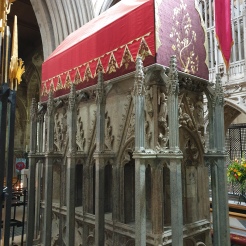The Cathedral and Abbey Church of St Alban
Offa II of Mercia is said to have founded a double monastery in St Albans in 793 which followed the Benedictine rule. This abbey was sacked by the Danes around 890 and lay empty from 920 until the 970s. There were plans to rebuild the the abbey in 1005 but Viking raids from 1016 stalled the Saxon efforts. Very little of the Saxon Abbey exists today in the current building.
Much of the current layout and proportions of the structure date from the first Norman Abbot, Paul of Caen (1077-1093). Building work commenced in the year of his arrival. The cruciform abbey was the largest built in England at that time. The tower and and crossing were the first parts to be built – the tower, at 44.5m tall is the only Norman great crossing tower still standing in England. The abbey was completed in 1089 but not consecrated until 1115 on Holy Innocents Day.
After the Dissolution of the Monasteries the building was looted and the abbot and remaining monks pensioned off. Over the years the building fell into disrepair and suffered neglect and second rate repairs. It was only in the 19th century that there were efforts to restore the building especially by Sir George Gilbert Scott and Edmund Beckett, Lord Grimthorpe.
Scott worked on the restoration of the Abbey from 1856 until his death in 1878. Together with with the Clerk of Works, John Chapple he saved the tower from collapsing in 1870. In 1877, the Abbey church became the Cathedral for the new diocese of St Albans. Lord Grimthorpe then played a controversial part in the Cathedral’s restoration. He agreed to pay for the work provided his own designs were used. One such instance was the redesign of the west front in 1880 replacing a fine 15th century window.















